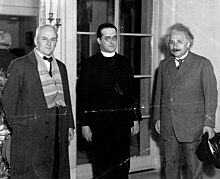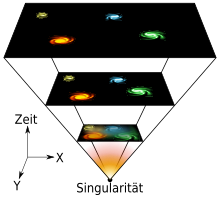Georges Lemaître
Georges Edouard Lemaître (born July 17, 1894 in Charleroi , Belgium , † June 20, 1966 in Leuven , Belgium) was a Belgian theologian, Catholic priest and astrophysicist . He is considered to be the founder of the big bang theory .
life and work
From a young age, Lemaître wanted to become a priest and scientist. At the age of 17 he moved from a Jesuit school to the Catholic University of Leuven . During the First World War he fought as a volunteer in an artillery unit of the Belgian army . After the war he continued his studies in Leuven , but switched from technology to physics and mathematics . Guided by his war experiences, he also enrolled in the seminary of the Archdiocese of Mechelen .
In 1920 he received his doctorate with the work L'approximation des fonctions de plusieurs variables réelles ("Approximation of functions of several real variables"). In 1923 he was ordained a priest . With his strong mathematical background learned from Charles-Jean de La Vallée Poussin , he continued his studies at Cambridge University until 1924 , where Arthur Eddington introduced him to modern stellar astronomy and numerical analysis .
Between 1924 and 1927 he studied at the Massachusetts Institute of Technology with a doctorate. In 1925 he took over a part-time professorship at the University of Leuven .
In Leuven he began to write down his ideas for the expansion of the universe . His work first appeared in 1927 in the Annales de la Société scientifique de Bruxelles , a rather little-known specialist journal . His work, which already laid out the main features of the expansion of the universe, thus appeared two years earlier than the work of Edwin Hubble , to whom the concept of the expansion of the universe had previously been ascribed, and after the corresponding work of the Russian mathematician Alexander Alexandrowitsch Friedmann, who died in 1925 who found this solution of Einstein's field equations first according to today's knowledge. Friedmann's work was probably not known to Georges Lemaître, but Albert Einstein was very much known , who also commented on them.

It was not until 1931 that Lemaîtres' essay appeared, in which he introduced the idea of the Big Bang as the quantum physical beginning of cosmic expansion into cosmology, also in English, but shortened by the crucial passages, the constant known today as the Hubble constant and calculations of the rate of expansion of the universe. Since he carried out the translation himself, he left out the passages which, in his opinion, had already been explained in more detail by Hubble in 1929. Although Lemaître never tried to claim a first-time exploration right, the International Astronomical Union (IAU), the world's largest astronomical association with a good 12,000 members, after a vote in October 2018, advocated the Hubble relation, which describes the relationship between distance and speed, The Hubble-Lemaître relationship.
Lemaître inevitably also dealt with the question of the compatibility of Catholic creation doctrine and the scientific big bang theory. In December 1940 he was appointed to the Pontifical Academy of Sciences because of his scientific achievements . In 1960 Lemaître became President of the Academy. With this office, which he held until his death, the bestowal of the title of papal prelate was connected.
In the 1950s Lemaître followed the advent of electronic computing systems, the computers, with great interest . In 1958 he had the first such device installed at the University of Leuven, a Burroughs E 101 .
In 1964 he retired . His most famous students include André Deprit , one of the inventors of the modern technology of the fast Fourier transform (mathematical algorithm), and Georges Papy , specialist in the didactics of modern mathematics. Throughout his life he remained a loner who did not have many contacts with fellow scientists. His correspondence is minimal.
Shortly before his death, Lemaître learned of the discovery of cosmic microwave radiation , which corroborated his theory.
Big bang theory
Lemaître presented his ideas at a congress in London that dealt with the origin of the universe and spirituality . He described his idea of the origin of the universe as a primordial atom, "a cosmic egg that exploded at the moment the universe came into being". All of the matter present in the universe today is said to have been compressed in this primordial atom. Among other things, he used the redshift of distant galaxies . His critics then referred to the theory as the Big Bang theory (or Big Bang ). Eddington and Einstein rejected it at first because, in their opinion, it was too close to a religious conception of the creation of the world and because from a physical point of view it had many imperfections, such as singularities . The dispute over this lasted for several decades. On a joint trip to California , Lemaître finally succeeded in convincing Einstein of his theory after he had explained it to him in detail.
At a meeting in November 1951, the Pontifical Academy of Sciences accepted Lemaîtres theory. Pope Pius XII In a concluding lecture he stated that the beginning of the world, which was fixed in time with the Big Bang, had arisen from a divine act of creation.
Honors
- On March 17, 1934, Lemaître received the Francqui Prize , the highest scientific award in Belgium, from King Leopold III.
- 1936 Jules Janssen Prize
- The classic standard model of the big bang theory is named after him the Lemaître universe .
- On the occasion of his 100th birthday, Charleroi, the city of his birth, named the main road leading to the airport after him.
- The Institute for Astronomy and Geophysics of the Catholic University of Leuven bears his name.
- An asteroid of the main belt, (1565) Lemaître , was named after him.
- The lunar crater Lemaître bears his name.
- The fifth ESA Automated Transfer Vehicle (ATV) to supply the International Space Station was named Georges Lemaître.
Individual evidence
- ^ A b J. J. O'Connor, EF Robertson: University of St. Andrews. Georges Henri-Joseph-Edouard Lemaître. Retrieved July 22, 2014 .
- ↑ Ulf von Rauchhaupt , The Father of the Big Bang , Frankfurter Allgemeine Sonntagszeitung, July 20, 2014, page 46
- ↑ Georges Henri-Joseph-Edouard Lemaître: Un univers homogène de Masse constante et de rayon croissant, rendant compte de la vitesse radiale des nébuleuses extra-galactiques. Provided by the NASA Astrophysics Data System. Retrieved July 22, 2014 . PDF
- ↑ G. Lemaitre: Un Univers homogeneous de masse constante et de rayon croissant rendant compte de la vitesse radiale des nebuleuses extra-galactiques . In: Annales de la Societe Scientifique de Bruxelles , A47, 1927, pp. 49-59.
- ↑ G. Lemaître: Expansion of the universe, A homogeneous universe of constant mass and increasing radius accounting for the radial velocity of extra-galactic nebulae . In: Monthly Notices of the Royal Astronomical Society . tape 91 , March 1931, p. 483-490 , bibcode : 1931MNRAS..91..483L .
- ^ Mario Livio: Mystery of the missing text solved. In: Nature , Volume 479, 2011, pp. 171-173, doi: 10.1038 / 479171a
- ↑ Otto Wöhrbach: Who really discovered the expansion of space? Retrieved December 12, 2019 .
- ^ Picture by Lemaître and Einstein. spiegel.de, accessed on July 22, 2014 .
- ↑ Francis Schussler Fiorensa, John P. Galvin: Systematic Theology: Roman Catholic Perspectives (Theology and the Sciences). 2011, Fortress Press, US, ISBN 9780800662912 , p. 230.
- ^ Fifth ATV named after Georges Lemaître. ESA, February 16, 2012, accessed February 17, 2012 .
literature
- Helge Kragh : Matter and Spirit in the Universe. Scientific and religious preludes to modern cosmology . Imperial College Press, London 2004, ISBN 1-86094-485-X ; therein Chapter 4: The Pirmeval-atom Universe .
- Hartmut Lohmann: Georges Lemaître. In: Biographisch-Bibliographisches Kirchenlexikon (BBKL). Volume 4, Bautz, Herzberg 1992, ISBN 3-88309-038-7 , Sp. 1402-1405.
- Harry Nussbaumer: Eighty Years of Expanding Universe. In: Sterne und Weltraum ISSN 0039-1263 , Vol. 46 (2007), No. 6, pp. 36-44.
- Wolfgang Schatz: Georges Lemaître . In: Astro-News , published by the Astronomical Working Group Pforzheim 1982 eV, Issue 3, 2012, pp. 17-18.
- Hans-Joachim Blome: The discovery of the Big Bang: Georges Lemaître and modern cosmology. Munich: CH Beck, 2016. ISBN 340669215X .
Web links
- Publications by G. Lemaitre in the Astrophysics Data System (ADS)
- Obituaries for G. Lemaitre in the Astrophysics Data System
- Mark Midbon: 'A Day Without Yesterday': Georges Lemaître & the Big Bang. In: Commonweal Magazine 127, No. 6. March 24, 2000, pp. 18-19 (reproduced on the Catholic Education Resource Center website).
- Ulf von Rauchhaupt: Revolution of our worldview: The father of the big bang. In: faz.net . July 26, 2014 .
- Agathe Lukassek: This Belgian priest founded the Big Bang theory. In: kathisch.de . 17th July 2018 .
| personal data | |
|---|---|
| SURNAME | Lemaître, Georges |
| ALTERNATIVE NAMES | Lemaître, Georges Edouard |
| BRIEF DESCRIPTION | Belgian priest and physicist; is considered the founder of the big bang theory |
| DATE OF BIRTH | July 17, 1894 |
| PLACE OF BIRTH | Charleroi ( Belgium ) |
| DATE OF DEATH | June 20, 1966 |
| Place of death | Lions |


